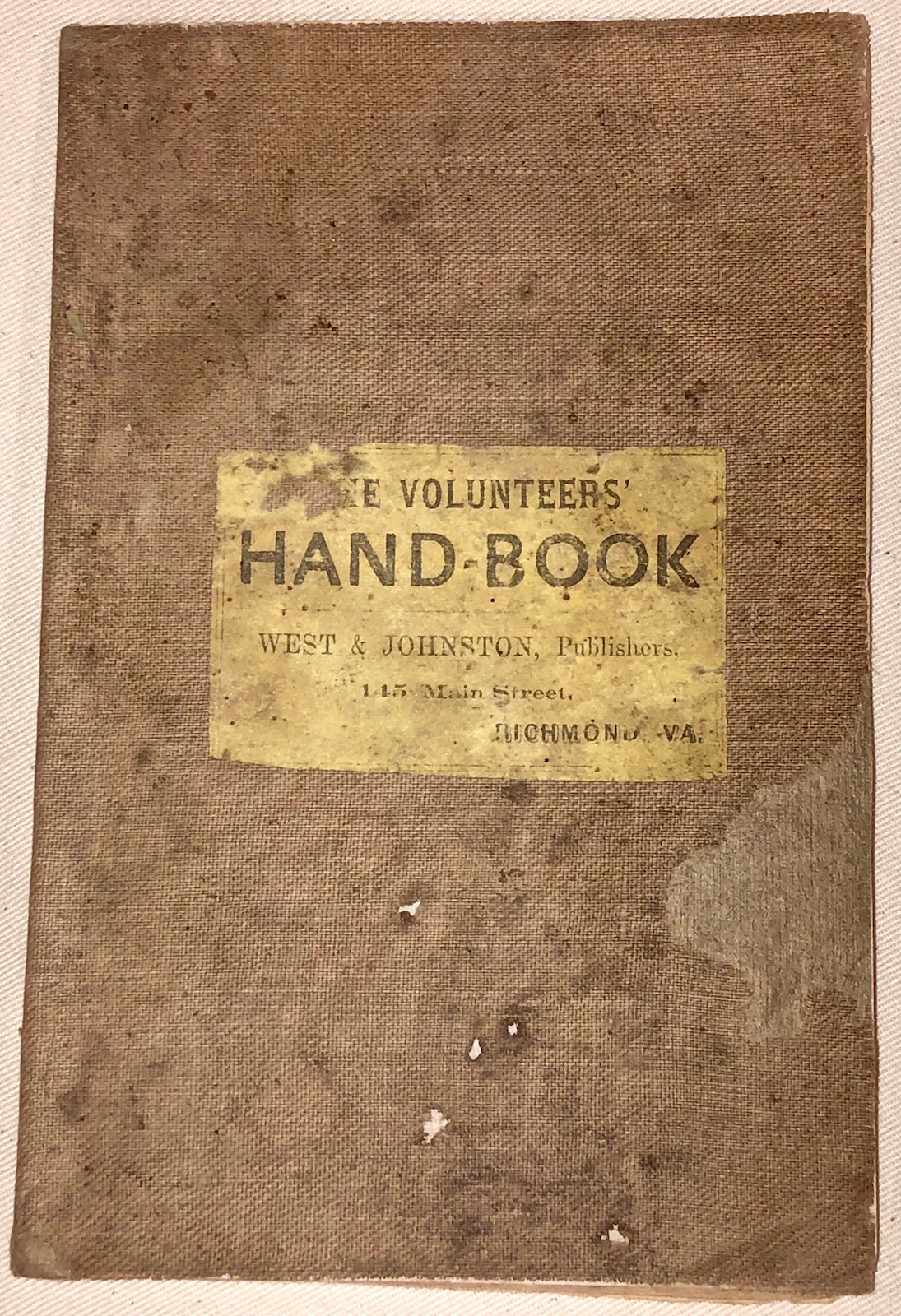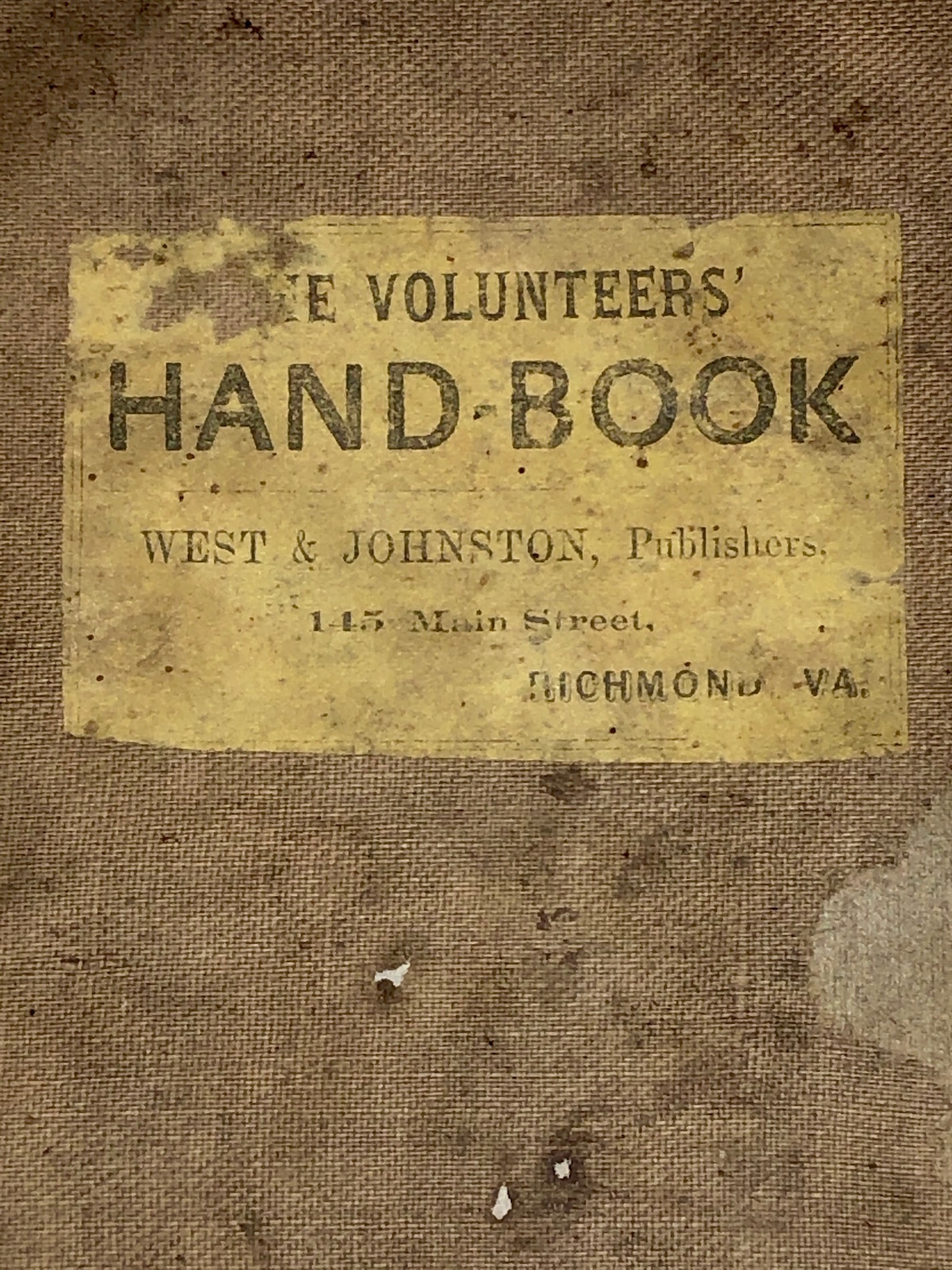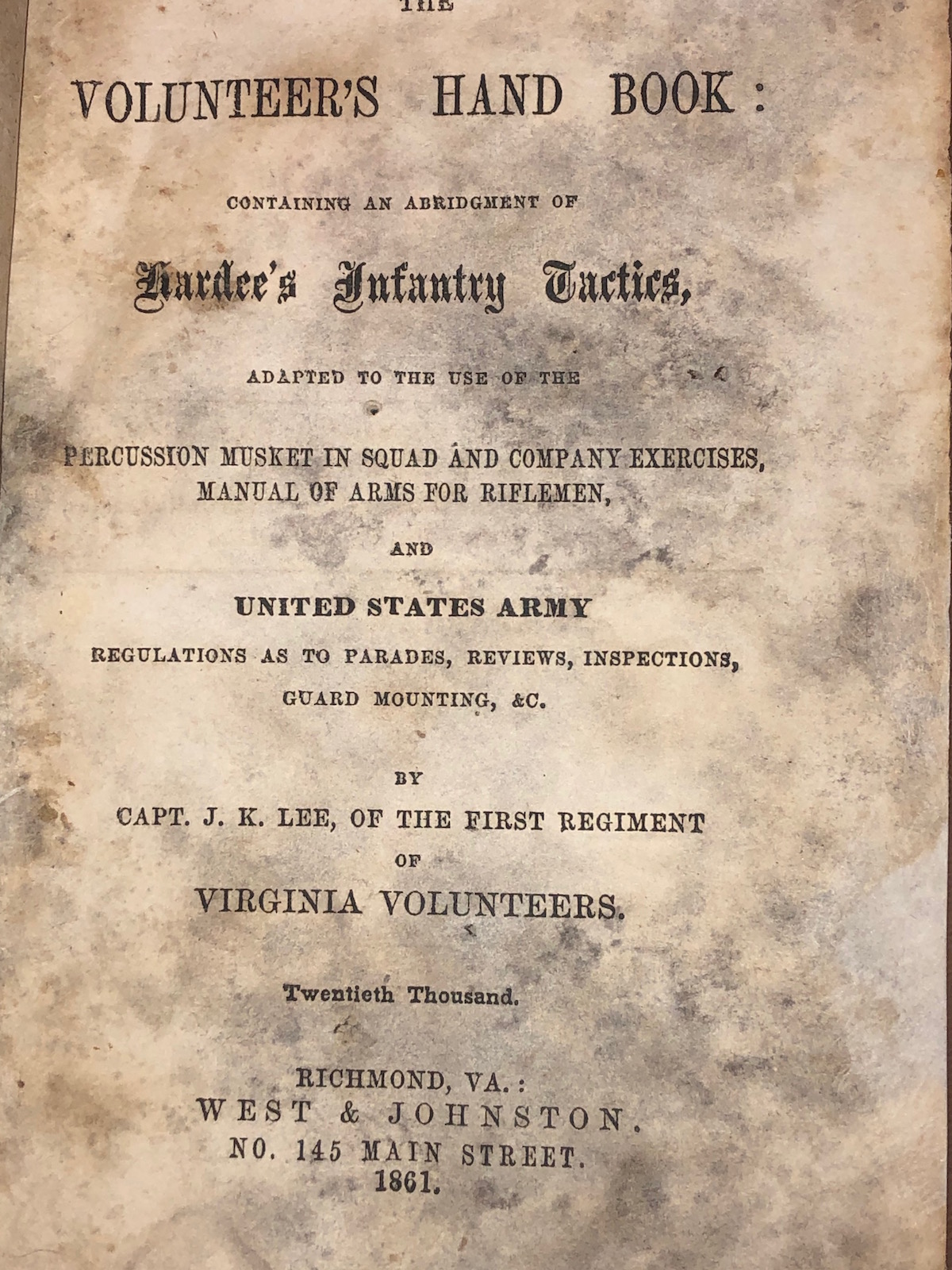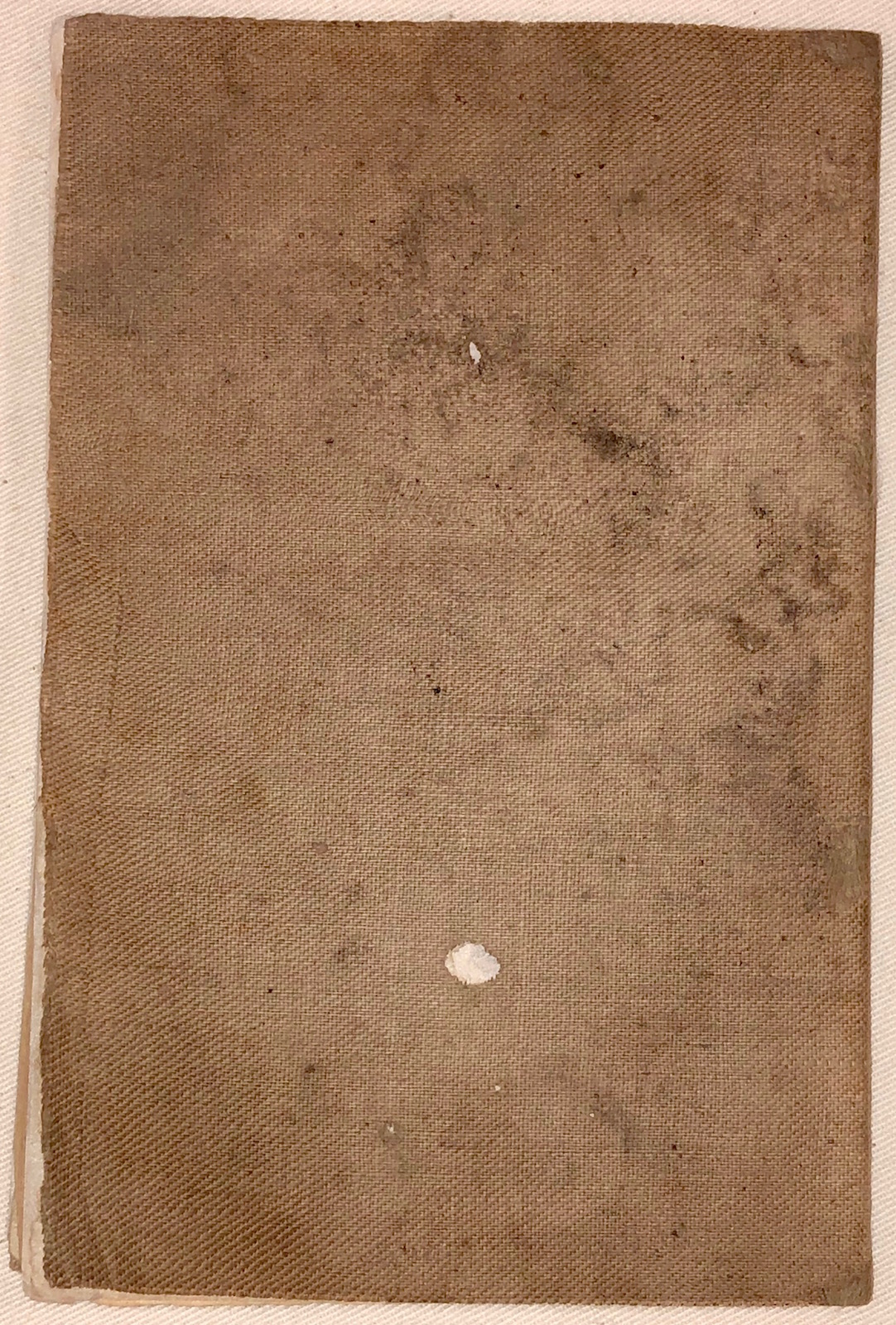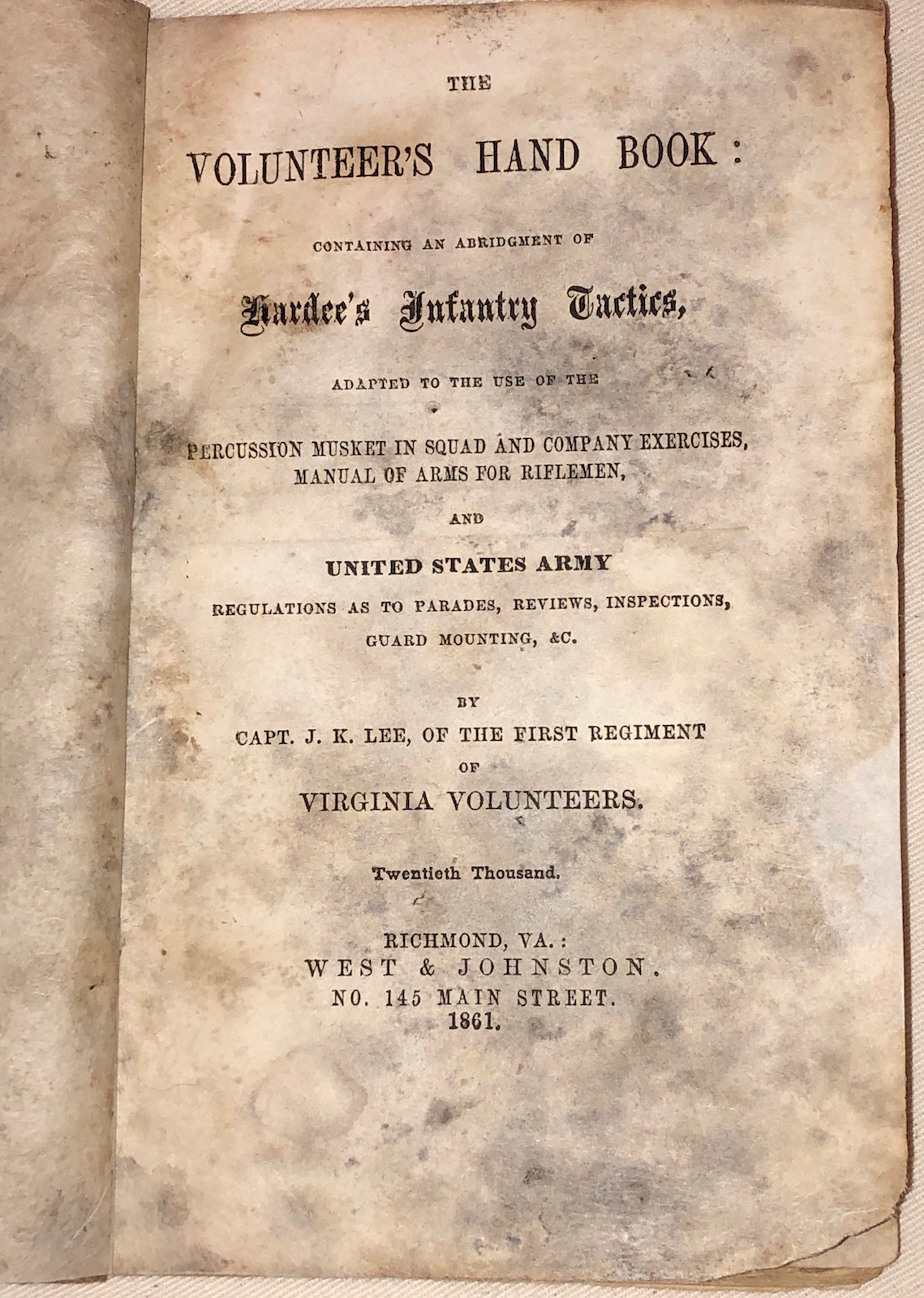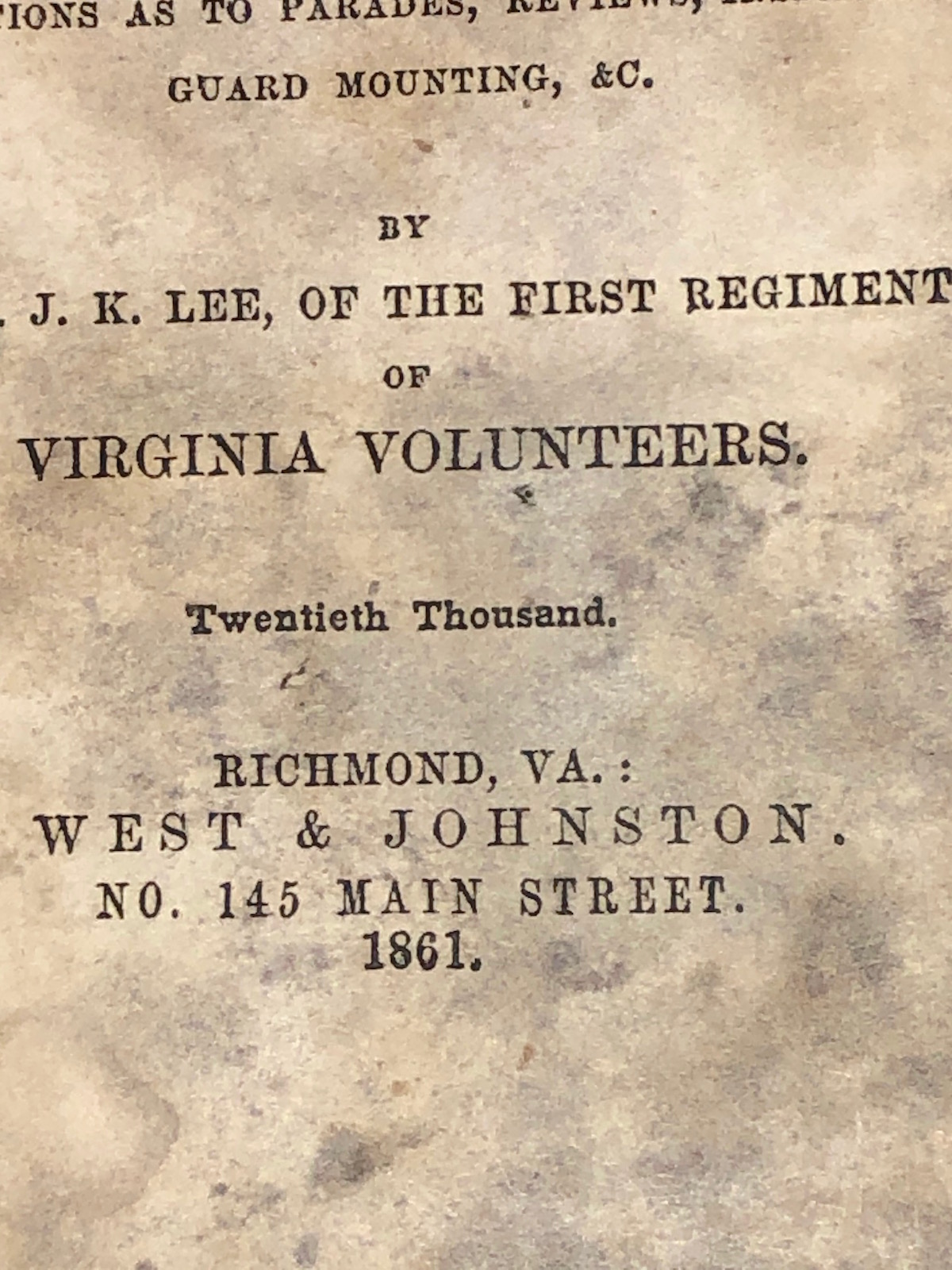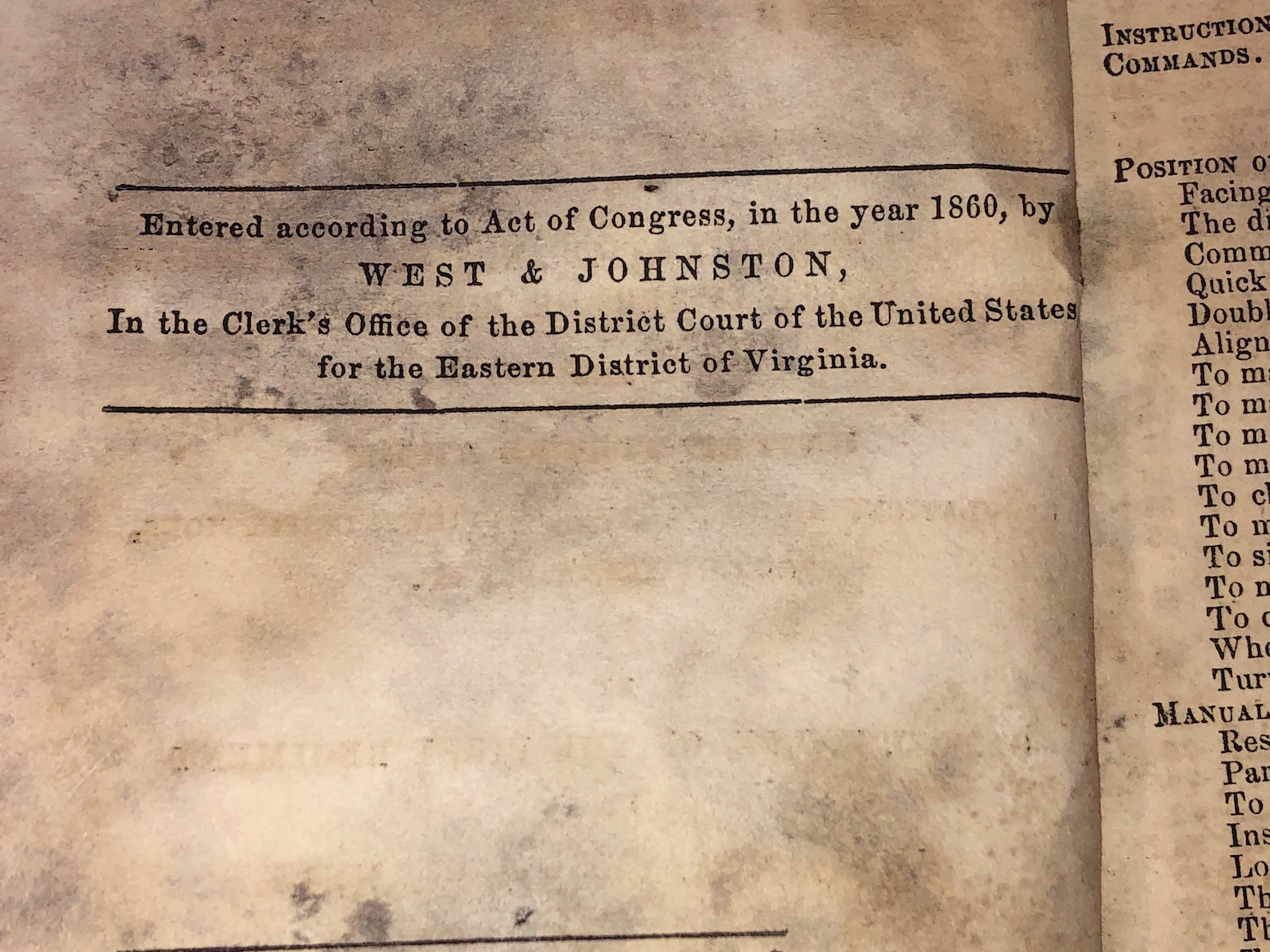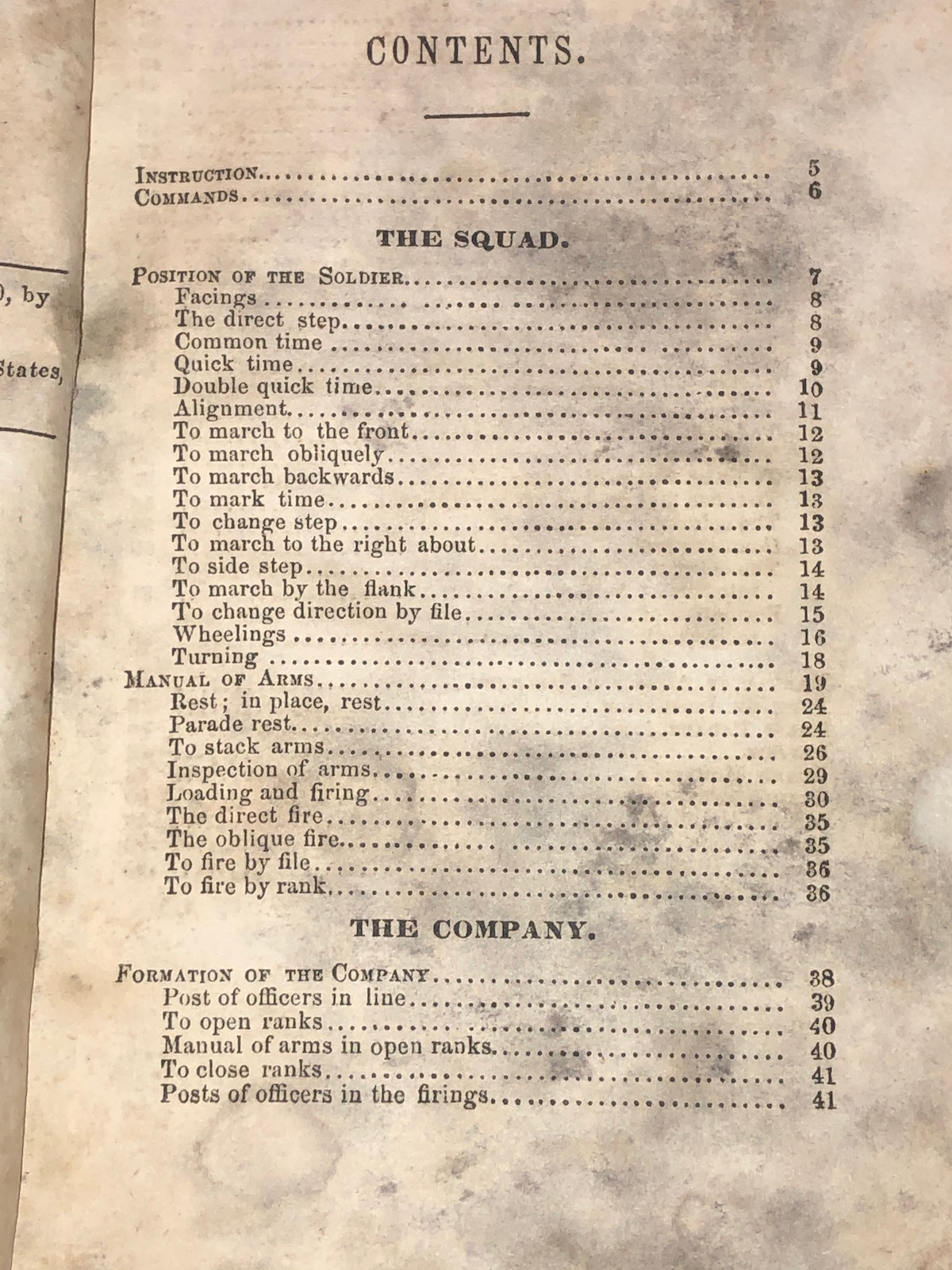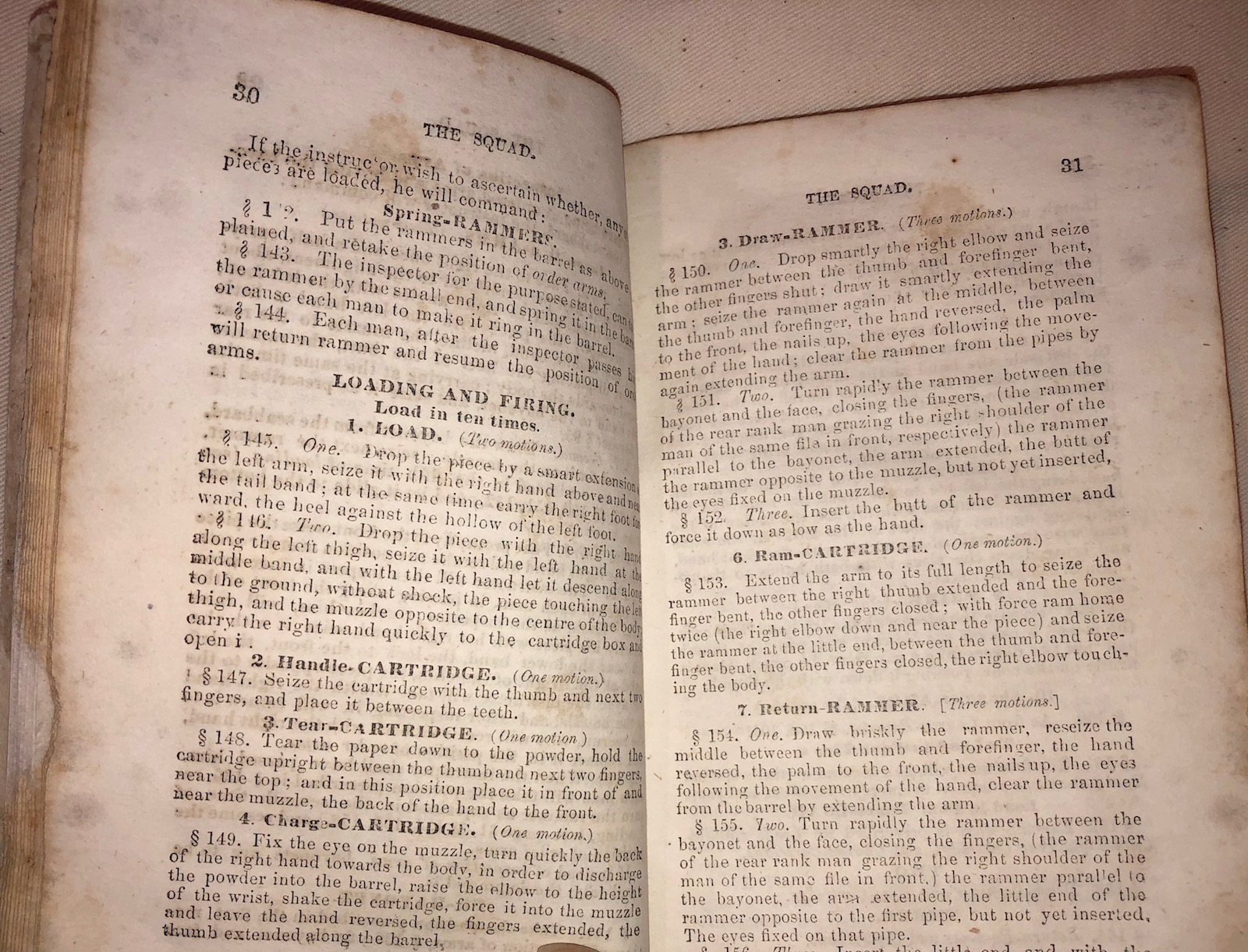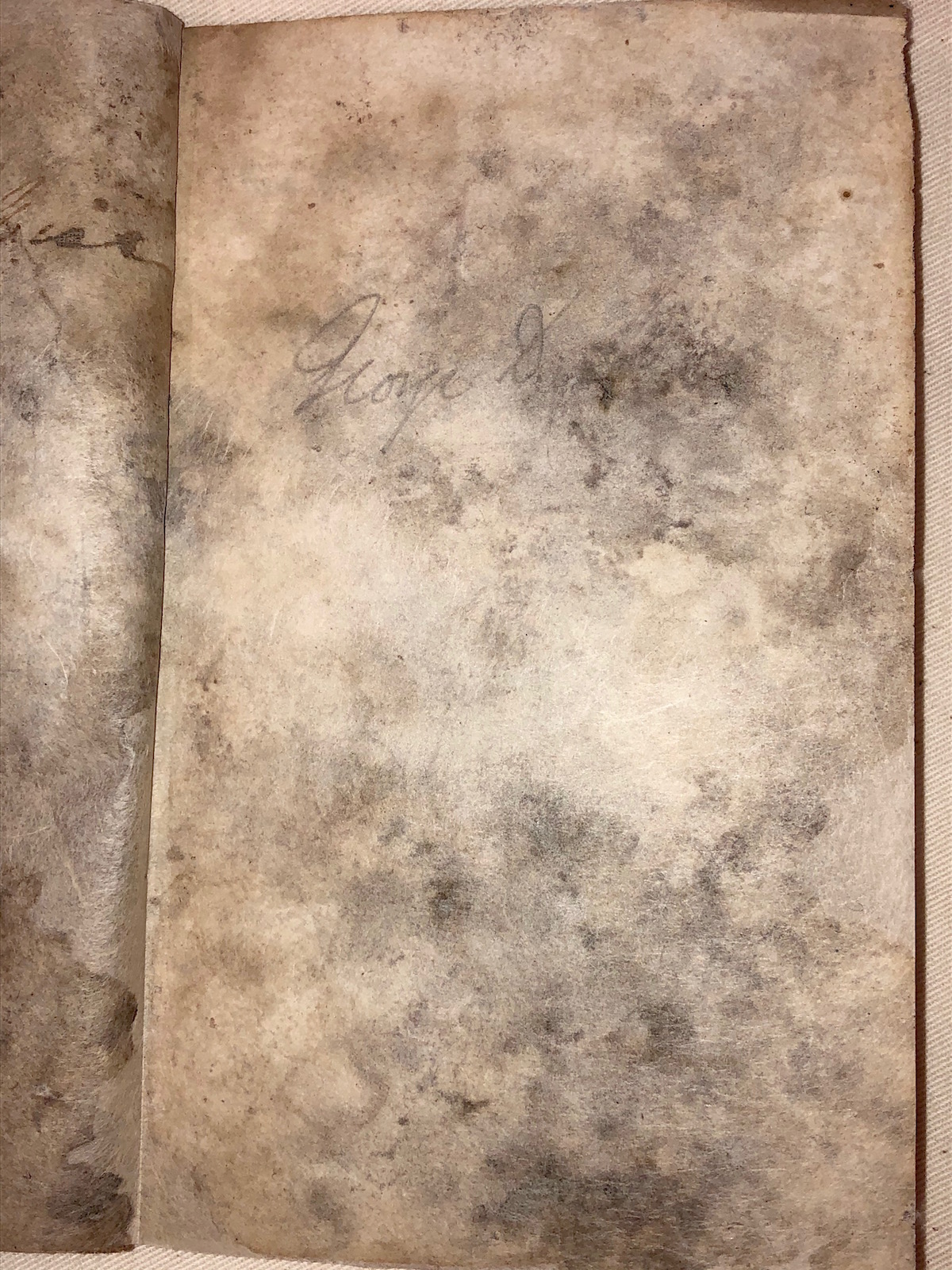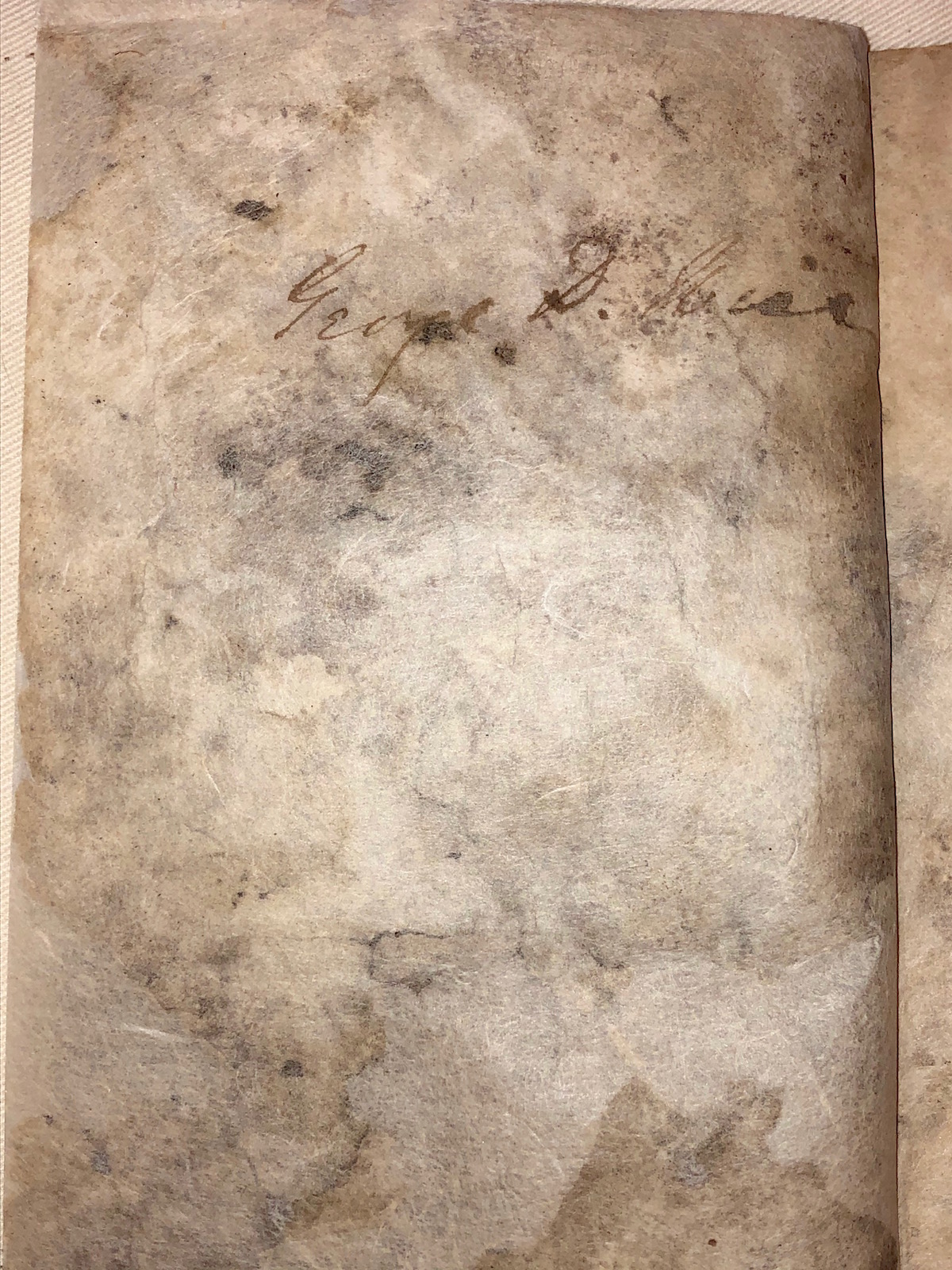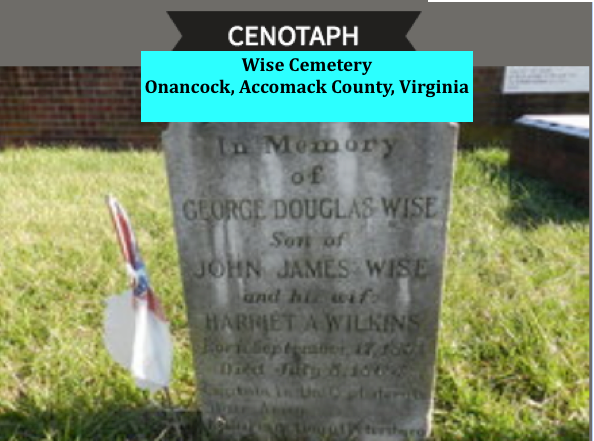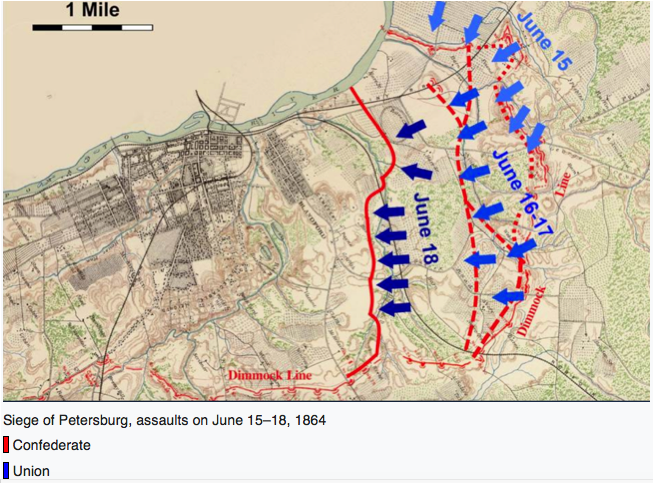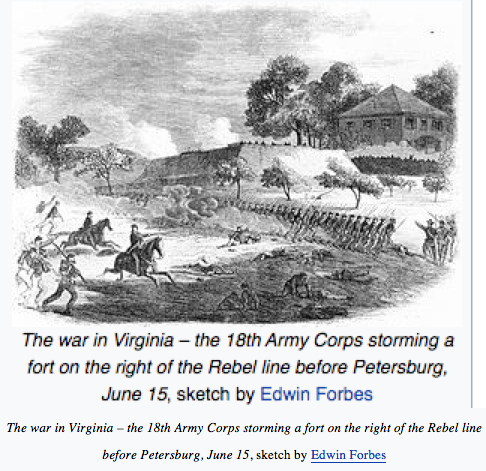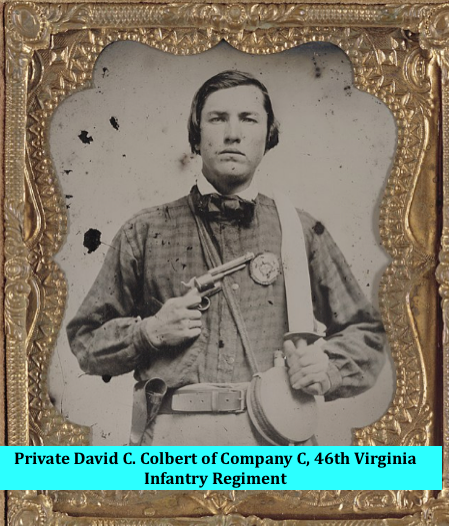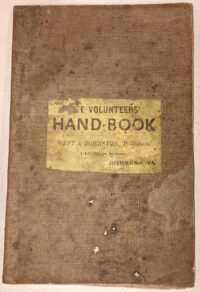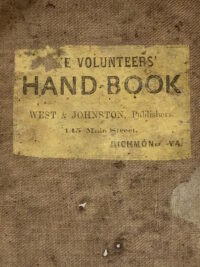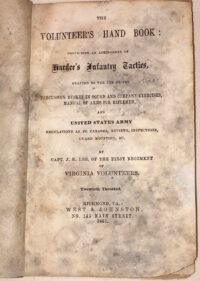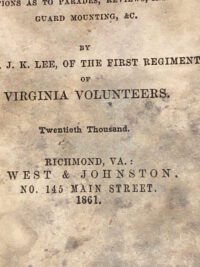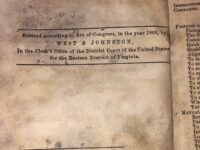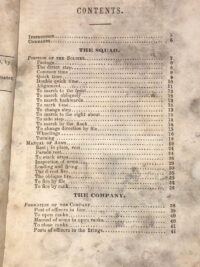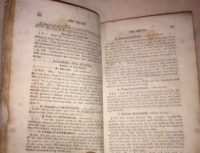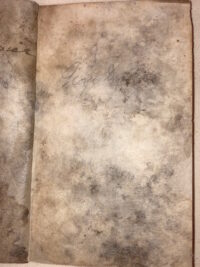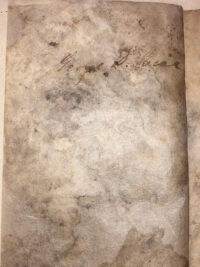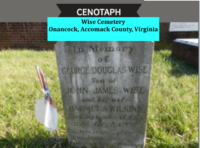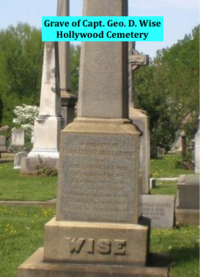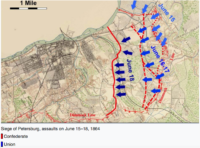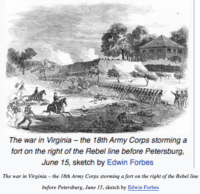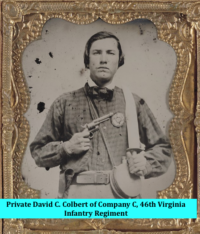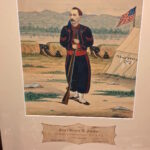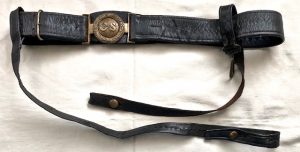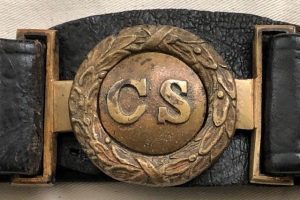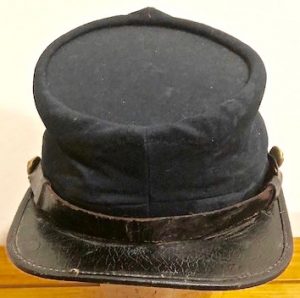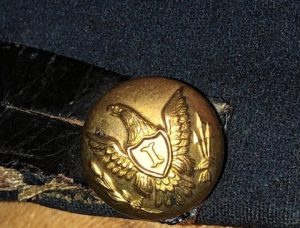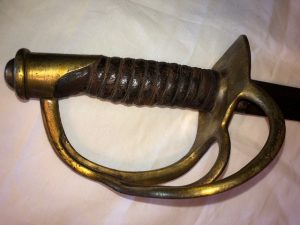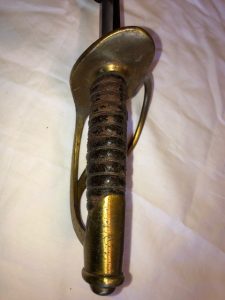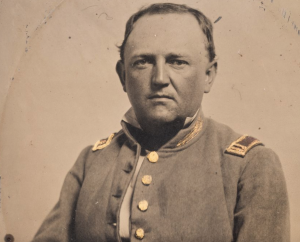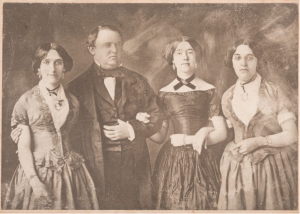Rare Richmond Imprint “The Volunteers’ Handbook” Owned by George D. Wise, 46th Va. Inf. – Mortally Wounded in Petersburg
SOLD
Rare Richmond Imprint “The Volunteers’ Handbook” Owned by George D. Wise, 46th Va. Inf. – Mortally Wounded in Petersburg – This rare West & Johnston of Richmond imprint of an abridged version of Hardee’s tactics, was printed in 1860. The small book is cloth bound, with a heavy weave, coarse, brown cotton, which remains in reasonably good condition. On two of the initial flyleaves appears the signature of “George D. Wise”, one in ink and one in pencil. Wise, from Accomack County, Virginia, was the nephew of Virginia governor and later Confederate General Henry Wise. Enlisting in 1862, in the 46th Virginia Infantry, Captain Wise would ultimately become an Aide to his uncle. George Wise was mortally wounded, in the trenches of the Dimmock line, in Petersburg, on June 17, 1864 and died, after a stay in the Virginia Hospital, in Petersburg, on July 5, 1864.
This rarely found book remains in overall good condition; Captain Wise obviously carried the book in the field, as it has some water stains and signs of weather impact. Regardless, the book’s cover is complete, and all pages are present.
George D. Wise
| Residence was not listed; Enlisted as a Private (date unknown). Promotions: * 2nd Lieut 5/14/1862 * Capt 11/2/1863 He also had service in: VA 46th Infantry (Nephew of Gnl Wise. Brother of Henry, Jr. and O.J.)
46th VA Infantry
In Sean Michael Chick’s book, “The Battle of Petersburg, June 15-18, 1864”, the mortal wounding of Captain Wise, along with the death of Confederate Colonel Page, the officer in charge of Wise’s Brigade, with Captain Wise at the same location, is described as follows: “In the lines between Potter’s division and the brigades of Faison and Wise, a particularly nasty sniper’s war occurred. Slowly a defensive position took shape, although it was too close to Potter’s snipers, and construction of the line went slowly. The 56th North Carolina, recalled from guarding the Matoaca Mill, had three men killed as they fortified the new line. One of the victims of this exchange was Colonel Pate, who led Wise’s brigade on the Confederate right. He was wounded at Battery 16as the 26th Virginia tried to stymie Potter’s gains. The regiment’s chaplain stayed to handle his funeral, which was to be held the following day. With Wise’s brigade having taken such heavy losses, Beauregard ordered Wise himself to Petersburg as he was anxious not to lose him. Thomas Goode, a Virginia Military Institute graduate and old army officer, took over. With Page dead, it was decided to abandon Battery 16 and to send the battered 26th Virginia to the rear. Capt. George D. Wise, a relative of Henry Wise, was mortally wounded soon after Page fell. His death, along with that of Page, caused particularly bad blood between Wise and Johnson. Wise never forgave the Ohio Quaker for the tragedy of Potter’s attack or for being promoted ahead of Wise to command the division.”
|
Captain George Douglas Wise (1831-1864) served as AAIG to his uncle General Henry A. Wise, a former Governor of Virginia, beginning in 1862 until he was mortally wounded in action at Petersburg 17 June 1864 and dying of his wounds on 5 July 1864.
The old college goes to war: the Civil War experiences of William and Mary students, faculty, and alumni
https://scholarship.richmond.edu/cgi/viewcontent.cgi?article=2205&context=masters-theses
The graduate contingent was also much larger than the student body, which produced more alumni casualties. At least seven alumni were killed in battle, including George Wise, Obediah Wise, and Hill Carter. George Wise was killed before the Battle of Petersburg, Obediah died earlier in the war at Roanoke Island in North Carolina, and Carter died during the Battle of the Chancellorsville in May 1863. Furthermore, Union forces captured George Blow, an 1831 graduate and lieutenant colonel in the 14th Virginia Infantry, during the fall of Norfolk in 1862. Octavius Coke, a captain in the 32″d Virginia who attended the college from 1857 to 1858, escaped death but suffered serious injuries at the Battles of Antietam and Five Forks, including a gunshot wound in the left hip.
Page 67
| NAME: | Geo. D. Wise |
| GENDER: | Male |
| MARITAL STATUS: | Single |
| AGE: | 28 |
| BIRTH DATE: | 1831 |
| BIRTH PLACE: | Accomack Co., VA. |
| MARRIAGE DATE: | 13 Dec 1859 |
| MARRIAGE PLACE: | Isle of Wight, Isle of Wight, Virginia |
| FATHER: | Jno. J. |
| MOTHER: | Harriett |
| SPOUSE: | Maryetta Atkinson |
| NAME: | George Douglas Wise |
| BIRTH DATE: | 17 Sep 1831 |
| BIRTH PLACE: | Accomack County, Virginia, United States of America |
| DEATH DATE: | 5 Jul 1864 |
| DEATH PLACE: | Petersburg City, Virginia, United States of America |
| CEMETERY: | Hollywood Cemetery |
| BURIAL OR CREMATION PLACE: | Richmond, Richmond City, Virginia, United States of America |
| HAS BIO?: | Y |
| FATHER: | John James Wise |
| MOTHER: | Harriet A Wise
|
CPT George Douglas Wise
| BIRTH | 17 Sep 1831
Accomac, Accomack County, Virginia, USA |
| DEATH | 5 Jul 1864 (aged 32)
Petersburg City, Virginia, USA |
| CENOTAPH | Wise Cemetery
Onancock, Accomack County, Virginia, USA |
46th Virginia Infantry Regiment
| 46th Virginia Infantry Regiment | |
| Active | August 1861 – April 1865 |
| Disbanded | April 1865 |
| Country | Confederacy |
| Allegiance | Confederate States of America |
| Role | Infantry |
| Engagements | American Civil War |
The 46th Virginia Infantry Regiment was an infantry regiment raised in Virginia for service in the Confederate States Army during the American Civil War. It fought mostly in Virginia and the Carolinas.[1]
46th Infantry Regiment (also called 1st or 2nd Regiment, Wise Legion) was organized in August, 1861.
It was soon ordered to North Carolina and placed in a brigade commanded by former governor Henry A. Wise. After Wise fell severely ill with pleurisy (and was confined to bed for a week), Federal forces captured Roanoke Island. Although only 23 Confederates died in the 2-day battle before Wise’s second in command surrendered, those dead included Wise’s eldest son Capt. Obediah Jennings Wise (editor of the Richmond Enquirer before the war and whose funeral at St. James Church in Richmond would be the capitol’s most elaborate before that of Stonewall Jackson the following year)[2] and Roberts Coles (son of former Illinois Territorial Governor and abolitionist Edward Coles).[3]
Following a prisoner exchange, as well as additional soldiers being added to replace those who failed to re-enlist and those lost through disease and to a lesser extent, battle casualties, the unit reassembled in Virginia, saw some action in the Seven Days’ Battles in June 1862. This unit contained 401 effectives during the Seven Days’ Battles. Afterward, it remained in Virginia and mainly dealt with false alarms about Union troop movements on the James River, then for the next 16 months, remained stuck on the Peninsula as a counterforce to the Union presence at Norfolk and Fortress Monroe.[4] Then, the 46th Virginia was reassigned to the Department of South Carolina, Georgia, and Florida. It defended besieged Charleston, before returning to Virginia during the spring of 1864. It then endured the hardships of the lengthy Petersburg trenches north of the James River and helped set the Confederate capitol afire per orders as the CSA army evacuated. During the final Appomattox Campaign, many officers and men were captured during the Battle at Sailor’s Creek. Fifteen officers and 116 men surrendered on April 9, 1865 at Appomattox.
The field officers were Colonels J. Lucius Davis, Richard T. W. Duke, Randolph Harrison, and John H. Richardson; Lieutenant Colonel Peyton Wise; and Majors Hugh W. Fry, Jr. and James C. Hill.
George Douglas Wise
| BIRTH | 17 Sep 1831
Accomack County, Virginia, USA |
| DEATH | 5 Jul 1864 (aged 32)
Petersburg City, Virginia, USA |
| BURIAL | Hollywood Cemetery
Richmond, Richmond City, Virginia, USA |
| PLOT | There’s monument. Don’t know plot no. |
This man, who fought for the Confederacy, and died of wounds received in battle, had been confused with the U.S. Congressman by same name.
He has two memorial pages on FindAGrave, because he has two markers. The first one, in Wise Cemetery in Accomack County, Virginia, is a memorial stone only, because his body was reinterred to Hollywood Cemetery (here), where he has a large monument.
Family Members
Parents
1794–1834
1802–1885
Siblings
1830–1896
1831–1864
1833–1840
CONFEDERATE VIRGINIA TROOPS
46th Regiment, Virginia Infantry
OVERVIEW:
46th Infantry Regiment [also called 1st or 2nd Regiment, Wise Legion] was organized in August, 1861. It was soon ordered to North Carolina and placed in Wise’s Brigade. Here part of the unit was captured in the fight at Roanoke Island. After being exchanged it was assembled in Virginia, saw action in the Seven Days’ Battles, then joined the Department of South Carolina, Georgia, and Florida. The regiment participated in the siege against Charleston and during the spring of 1864 returned to Virginia. It endured the hardships of the Petersburg trenches north of the James River and ended the war at Appomattox. This unit contained 401 effectives during the Seven Days’ Battles and surrendered 15 officers and 116 men on April 9, 1865. The field officers were Colonels J. Lucius Davis, Richard T.W. Duke, Randolph Harrison, and John H. Richardson; Lieutenant Colonel Peyton Wise; and Majors Hugh W. Fry, Jr. and James C. Hill.
OR LI P1: Report of Captain John H. White, 46th VA, June 17, 1864
Report of Captain John H. White, Forty-sixth Virginia Infantry, of operations June 17.1
HEADQUARTERS FORTY-SIXTH VIRGINIA REGIMENT,
In the Trenches, July 19, 1864.
COLONEL: In compliance with your request of yesterday, I have the honor to submit the following as my observation on the part taken by the Forty-sixth Virginia Regiment in the engagement of June 17. In presenting this I beg leave to remark that as the brigade was divided by the Twenty-third South Carolina Volunteers, or, as I have since learned, by a detachment of that regiment, on our left, I cannot speak of the movement of any but my own regiment:
Early in the forenoon of the 17th ultimo we received orders to move to the right of the line and take position immediately on the right of the Twenty-third South Carolina Volunteers, Elliott’s brigade. At this point it was necessary to construct breast-works, and in doing which my men were exposed to the fire both of the enemy’s sharpshooters and batteries; the work was accomplished, however, to a slight degree, barely enough to afford [protection] to the men, when the enemy charged in our front and along the left of the line toward Clingman’s
brigade. His attack was handsomely repulsed, and about twenty of the Forty-sixth Virginia advanced in front of the works and captured some thirty-five prisoners. We were aware that the enemy were massing in large force, under cover of a hill in our front, and continued to work on the intrenchments until 6.30 p. m., when four Yankee flags were displayed above the crest of the hill with the evident design of drawing the fire of our men. This movement savored so strongly of the Yankee that our forces needed no telling to denounce it as a trick. Finding that his design was futile, the enemy immediately advanced four regiments in column by division, and when within 200 yards of our works the rear rank of the left wing was ordered to open fire upon him, which they did with great precision, that not only checked his advance but literally moved them down, all four of the flags, and when the smoke rose only a few could be seen struggling to the rear and right oblique. The firing of the Forty-sixth Virginia was for a short time continuous, and when it ceased in a measure the men were in a great glee at [the] easy success we had, when, looking to the left, to my utter astonishment and dismay, I saw the Twenty-third South Carolina Regiment leaving the trenches and scattering helter-skelter to the rear. We called on them to come back; cheered them; threatened to shoot some, and finally did shoot, but only a few of them could be stopped with us. Major Hill ordered the regiment to move by the left flank, and the left wing moved as directed, some of the men occupying part of the trenches so shamefully and disgracefully deserted by the Twenty-third South Carolina Regiment. An Alabama regiment passed me, and had, I supposed, re-enforced the lines. When Captain Cleveland, Forty-sixth Virginia, reported that the enemy had carried the works on our left in such overwhelming force that it was impossible for our left wing to hold our any longer, I reminded Captain C. that the Alabama regiment had gone to the left, and asked him to ascertain certainly who it was in the trenches. He returned in a few minutes and again informed me that the enemy had carried our works. I perceived at this time that the left was being forced back, which information was communicated to Major Hill, when he ordered the regiment to fall back to Blount’s battery, distant from where the right of our regiment rested about 100 yards, which they did in good order. Halting at the latter place, they were rallied almost instantly and quickly charged the works, carrying them as far as the left center of the regiment, and were still advancing when a Yankee officer called out, “What regiment is that?” Major Hill leaped upon a traverse and answered, “The Forty-sixth Virginia.” The response of the enemy came immediately, “Give it to them, boys.” A volley was poured in upon us, and here Major Hill, Ensign Rogers, and many others were killed and wounded; the flag staff was shot in two pieces of when we left the field there were eighteen holes through the colors. In some confusion the regiment fell back a short distance and the command devolved upon me. I rallied the men in as short time as possible and reported to you. This, sir, is a fair statement of the affair occurring as it did under my own eye, and I trust it may prove to the satisfaction of all concerned who it is that merits blame for the disaster.
I am, colonel, very respectfully, your obedient servant,
- H. WHITE,
Captain, Commanding Regiment.
Colonel J. THOMAS GOODE,
Commanding Wise’s Brigade.
On May 7, 1864, the 46th VA Infantry arrived in Petersburg to defend that area from the advancing Army of the Potomac. The movement of the Army of the Potomac to Petersburg was part of Grant’s effort to put extreme pressure on a number of the Union Army’s strategic objectives throughout southern Virginia. After seven and a half months in South Carolina, the 46th VA Infantry was at last back in Virginia, and it was to be a very violent homecoming. Though the regiment had endured its share of hardship in three years of war, it had yet suffered but few battle casualties. That was about to change. Gone were the endless weeks and months of guard duty, camp life, and being held in reserve. By May 17th, 1864, the 46th was entrenched near Bake-House Creek where it received its first tastes of trench warfare as they became engaged in fierce sharpshooting battles and heavy shellfire with the its Union enemy.
June 17, 1864, proved to be the 46th VA Infantry’s “Antietam.” Never before nor after did it suffer as many deaths and injuries in a 24-hour period as it did on that day. The compiled Service Records for the 46th VA Infantry show that at least 25 had been killed or mortally wounded, 87 wounded, and 19 captured, for a total loss of 131 soldiers. In the previous three days, the regiment had seem more action and suffered more casualties than it had in the three previous years of warfare combined. In the five weeks since its return to Virginia, 51 men of the 46th had been shot dead, 140 were wounded, and 25 captured, for a combined total of 216, or slightly more than one-third of the 46th’s soldiers who left South Carolina.
The next four months would continue to expose the 46th VA Infantry and other Confederate troops, holding the extreme left of the Petersburg trench line, to daily (and nightly) picket firing and sharpshooting which struck down dozens of the 46th’s soldiers. With two men to a hole forward of the trench line, the 46th Infantry regiment’s own sharpshooters were posted and relieved every twenty-four hours. The 46th “gave as good as is sent.”
The 46th VA Infantry was reunited with its colonel when Randolph Harrison, having recovered from his neck wound during a 4-month convalescence, returned to duty on October 27, 1864. His resumption of command, however, lasted but a few hours. As pickets in front of the 46th were being relieved at dusk that same evening, about 100 men from the 148th Pennsylvania dashed across no-man’s land with the intention of destroying Davidson’s Battery. Mistaken by some as incoming deserters and by others as picket relief, the Yankees made it across without being harmed. By the time the situation finally became clear, Colonel Harrison, who had just walked over to see what was going on, had been grabbed along with three other officers and thirteen men. The Yankees were then driven off with some loss, but Colonel Harrison and the rest of the captured men were not recovered. The 46th VA Infantry was then placed under the command of Captain John H. White.
Baldy Smith and his men crossed the Appomattox shortly after dawn on June 15. His force consisted of the infantry divisions of Brig. Gens. William T. H. Brooks, John H. Martindale, and Edward W. Hinks, and the cavalry division of Brig. Gen. August Kautz. The transport vessels delivered these divisions almost at random to landing sites on the opposite shore, confusing Smith’s plans and wasting time reorganizing. Kautz’s cavalry division was ordered to clear the line of advance for the infantry, Brooks and Martindale would march down the City Point Railroad, and Hinks’s U.S. Colored Troops would approach on the Jordan Point Road.[8]
Delays in the advance continued after the landing. The cavalry encountered an unexpected stronghold at Baylor’s farm northeast of Petersburg. Hinks’s men launched two attacks on the Confederates and captured a cannon, but the overall advance was delayed until early afternoon. Smith performed a reconnaissance and, despite his sense of nervousness about the strength of the enemy position, planned to carry the defensive works with a strong skirmish line. He was delayed again when his artillery commander allowed all of the horses to be watered simultaneously, making it impossible to bring up his guns until about 7 p.m.[9]
While Smith was delaying, Kautz reached the railroad near Redan number 20 on the right flank of the Confederate line around noon. Approximately 600 Confederates under Brig. Gen. James Dearing bombarded Kautz with artillery and the Union cavalrymen got no closer than 500 yards (460 m) from the line. In a manner similar to the June 9 battle, Kautz listened for evidence that Smith was attacking to his right and, hearing none, gave up and withdrew.[10]
When Smith finally started his attack, his skirmishers swept over the earthworks on a 3.5-mile (5.6 km) front, capturing Batteries 3 and 5–11, causing the Confederates to retreat to a weaker defensive line on Harrison’s Creek. Despite this initial success and the prospect of a virtually undefended city immediately to his front, Smith decided to wait until dawn to resume his attack. By this time Winfield Hancock had arrived at Smith’s headquarters. The normally decisive and pugnacious Hancock, who outranked Smith, was uncertain of his orders and the disposition of forces, and uncharacteristically deferred to Smith’s judgment to wait. Smith’s timid service on June 15 would turn out to be his last combat command. Butler indirectly accused Smith of “dilatoriness” and the dispute escalated to Grant. Although Grant originally contemplated replacing Butler by Smith as commander of the Army of the James, he eventually retained Butler and reassigned Smith to New York to await further orders, which were never issued.[11]
Beauregard wrote later that Petersburg “at that hour was clearly at the mercy of the Federal commander, who had all but captured it.” But he used the time he had been granted to good advantage. Receiving no guidance from Richmond in response to his urgent requests, he unilaterally decided to strip his defenses from the Howlett Line, which was bottling up Butler’s army in Bermuda Hundred, making the divisions of Maj. Gens. Robert Hoke and Bushrod Johnson available for the new Petersburg defensive line. Butler might have used this opportunity to move his army between Petersburg and Richmond, which would have doomed the Confederate capital, but he once again failed to act.[12]
June 16
By the morning of June 16, Beauregard had concentrated about 14,000 men in his defensive line, but this paled in comparison to the 50,000 Federals that now faced him. Grant had arrived with Maj. Gen. Ambrose Burnside‘s IX Corps, addressed the confusion of Hancock’s orders, and ordered a reconnaissance for weak points in the defensive line. Hancock, in temporary command of the Army of the Potomac until Maj. Gen. George G. Meade arrived, prepared Smith’s XVIII Corps on the right, his own II Corps in the center, and Burnside’s IX Corps on the left.[13]
Hancock’s assault began around 5:30 p.m. as all three corps moved slowly forward. Beauregard’s men fought fiercely, erecting new breastworks to the rear as breakthroughs occurred. Upon the arrival of General Meade, a second attack was ordered and Brig. Gen. Francis C. Barlow led his division against Redans 13, 14, and 15. Confederate artillery fire caused significant Union casualties, including the death of Col. Patrick Kelly, commander of the famous Irish Brigade. Although Barlow’s men managed to capture their objectives, a counterattack drove them back, taking numerous Union prisoners. The survivors dug in close to the enemy works.[14]
June 17
June 17 was a day of uncoordinated Union attacks, starting on the left flank where two brigades of Burnside’s IX Corps under Brig. Gen. Robert B. Potter stealthily approached the Confederate line and launched a surprise attack at dawn. Initially successful, it captured nearly a mile of the Confederate fortifications and about 600 prisoners, but the effort eventually failed when Potter’s men moved forward to find another line of entrenchments. Their mobility was limited because of tangled logs in a ravine behind them and Confederate guns were able to strike them with enfilade fire.[15]
At 2 p.m., the IX Corps launched a second attack, led by the brigade of Brig. Gen. John F. Hartranft. They were somehow sent forward at a right angle to the Confederate line, which left them vulnerable to enfilading fire. In the evening, Brig. Gen. James H. Ledlie‘s division also failed in its assault, during which Ledlie was observed to be drunk (a behavioral pattern that would repeat itself notoriously at the Battle of the Crater).[16]
We find the enemy, as usual, in a very strong position, defended by earthworks, and it looks very much as if we will have to go through a siege of Petersburg before entering on the siege of Richmond. … Well, it is all in the cruise, as the sailors say.
Maj. Gen. George G. Meade, letter to his wife, June 17[17]
During the day, Beauregard’s engineers had laid out new defensive positions a mile to the west of the Dimmock Line, running along a creek named Taylor’s Branch to the Appomattox. Late that night the Confederates pulled back to their new position. Beauregard expressed his frustration with the lack of support or concern from Robert E. Lee, writing years after the war, “The Army of Northern Virginia was yet far distant, and I had failed to convince its distinguished commander of the fact that I was then fighting Grant’s whole army with less than eleven thousand men.” Lee had systematically ignored all of Beauregard’s pleas and it was not until his own son, cavalry Maj. Gen. W.H.F. “Rooney” Lee, had verified Grant’s movements across the river, that he acknowledged the current perilous situation at Petersburg. He immediately dispatched two divisions of his men, exhausted from the Overland Campaign, to Petersburg, beginning at 3 a.m. on June 18.[18]
June 18
With the arrival of Lee’s two divisions, under Maj. Gen. Joseph B. Kershaw and Charles W. Field, Beauregard had over 20,000 men to defend the city, but Grant’s force had been augmented by the arrival of Maj. Gen. Gouverneur K. Warren‘s V Corps and 67,000 Federals were present. The first Union attack began at dawn, started by the II and XVIII Corps on the Union right. Hancock began to suffer effects from his lingering Gettysburg wound and he turned over command of the II Corps to Maj. Gen. David B. Birney. The men of the II Corps were surprised to make rapid progress against the Confederate line, not realizing that Beauregard had moved it back the night before. When they encountered the second line, the attack immediately ground to a halt and the corps suffered under heavy Confederate fire for hours.[19]
By noon, the IX and V Corps, which had a longer distance to march to join the attack, came up alongside the II Corps. Maj. Gen. Orlando B. Willcox‘s division of the IX Corps led a renewed attack but it suffered significant losses in the marsh and open fields crossed by Taylor’s Branch. Willcox’s division emerged with only 1,000 men standing. Warren’s V Corps was halted by murderous fire from Rives’s Salient (also known as Battery 27, the position where the Dimmock Line crossed the Jerusalem Plank Road, present-day U.S. Route 301), an attack in which Colonel Joshua Lawrence Chamberlain, commanding the First Brigade, First Division, V Corps, was severely wounded. His wound was believed to be mortal and Chamberlain was granted a battlefield promotion to brigadier general by General Grant. At 6:30 p.m., Meade ordered a final assault, which also failed with more horrendous losses. One of the leading regiments was the 1st Maine Heavy Artillery Regiment, 900 men that had been converted from essentially garrison duty manning artillery to be infantrymen at the start of the Overland Campaign. The regiment quickly lost 632 men in the assault, the heaviest single-battle loss of any regiment during the entire war.[20]
Aftermath
It is a source of great regret that I am not able to report more success.
Maj. Gen. George G. Meade, report to Lt. Gen. Grant, June 18[21]
Having achieved almost no gains from four days of assaults, Meade ordered his army to dig in. Union casualties were 11,386 (1,688 killed, 8,513 wounded, 1,185 missing or captured), Confederate 4,000 (200 killed, 2,900 wounded, 900 missing or captured).[3] Grant’s opportunity to take Petersburg easily had been lost, but Lee, who arrived at Petersburg around noon on June 18, was unable to prevent the Union army from laying siege to the city. The siege would last until April 1865.[22]
The Second Battle of Petersburg: June 15-18, 1864
Name: The Battle of Petersburg
Other Names: The Second Battle of Petersburg, Assault on Petersburg
Location: City of Petersburg
Campaign: Richmond-Petersburg Campaign (June 1864-March 1865)
Date(s): June 15-18, 1864
Principal Commanders: Lt. Gen. Ulysses S. Grant and Maj. Gen. George G. Meade [US]; Gen. Robert E. Lee and Gen. P.G.T. Beauregard [CS]
Forces Engaged: 104,000 total (US 62,000; CS 42,000)
Estimated Casualties: 11,386 total (US 8,150; CS 3,236)
Description: Marching from Cold Harbor, Meade’s Army of the Potomac crossed the James River on transports and a 2,200-foot long pontoon bridge at Windmill Point. Butler’s leading elements (XVIII Corps and Kautz’s cavalry) crossed the Appomattox River at Broadway Landing and attacked the Petersburg defenses on June 15. The 5,400 defenders of Petersburg under command of Gen. P.G.T. Beauregard were driven from their first line of entrenchments back to Harrison Creek. After dark the XVIII Corps was relieved by the II Corps. On June 16, the II Corps captured another section of the Confederate line; on the 17th, the IX Corps gained more ground. Beauregard stripped the Howlett Line (Bermuda Hundred) to defend the city, and Lee rushed reinforcements to Petersburg from the Army of Northern Virginia. The II, IX, and V Corps from right to left attacked on June 18 but was repulsed with heavy casualties. By now the Confederate works were heavily manned and the greatest opportunity to capture Petersburg without a siege was lost. The siege of Petersburg began. Union Gen. James St. Clair Morton, chief engineer of the IX Corps, was killed on June 17.
Result(s): Confederate victory
Summary:
The Second Battle of Petersburg occurred during a four day span from June 15-18, 1864, and it began 150 years ago today. As most of Grant’s army moved from the Cold Harbor battlefield to Petersburg via the James River, William F. “Baldy” Smith’s Eighteenth Corps, took transports from West Point down the York River, and back up the James River to Bermuda Hundred, reuniting Butler’s Army of the James. It would be a brief reunion. On the night of June 14, Smith took two of his own divisions under Brooks and Martindale along with Hinks’ USCT division of the Tenth Corps, crossed the Appomattox River, and marched on Petersburg.
Click to see maps of the Second Battle of Petersburg, which should help you follow along with the action.
The Second Battle of Petersburg, Day 1: June 15, 1864
Smith’s force reached Petersburg late on the morning of June 15, 1864, and what followed was one of the biggest missed opportunities of the entire Civil War. Smith had experienced the disastrous assault at Cold Harbor in early June, and he was determined not to repeat that debacle. After a careful reconnaissance of the strong but thinly held Dimmock Line east of Petersburg which took up most of the afternoon, Smith finally decided on an assault from approximately batteries 4 through 8 on Jordan’s Hill with a reinforced skirmish line. When it was determined to use the Eighteenth Corps artillery to support the assault, the guns were nowhere to be found. The Corps artillery chief, Captain Frederick Follett, had sent the horses back to be watered, and it took time to round them up and get the guns into position. By the time the artillery was ready. it was 7 pm and even more time had been wasted. Henry Wise, former Governor of Virginia, his Virginia Brigade and some Confederate militia were all that stood between Smith’s Corps and Petersburg.
The assault moved forward that evening and succeeded in carrying batteries 3 through 12 of the Dimmock line, forcing Beauregard and his Confederate forces to retreat that evening and dig a new line behind Harrison Creek. The scarcity of Confederate forces had made success inevitable, but Smith had no real way of knowing this until he attacked. Hinks’ USCT division played a decisive role in the assaults, and several hundred men from Wise’s Brigade were captured. As much success as Smith had, he could have achieved even greater results, but he failed to push forward in the darkness. This despite having Winfield Scott Hancock’s Second Corps, Army of the Potomac available starting around 9 pm. Hancock and his veterans would have been there sooner, but a series of delays and the failure of anyone to notify Hancock that he needed to march quickly retarded his appearance greatly. Hancock and Smith conferred that night, but Hancock as the ranking officer deferred to Smith’s judgment as to the wisdom of a night attack. Smith chose to wait, an amazed Beauregard and his Confederate forces breathed a sigh of relief and dug in behind Harrison’s Creek, and Grant would never have a better opportunity to take Petersburg until the day it fell nine and a half long, monotonous, and bloody months later.
More forces would arrive on both sides on June 16, 1864, day 2 of the Second Battle of Petersburg…
The Second Battle of Petersburg, Day 2: June 16, 1864
The first day of the Second Battle of Petersburg had seen the Confederate defenders driven back from the Dimmock Line to the western bank of Harrison Creek. Beauregard had received reinforcements through the night, with Hoke’s division arriving first, and then Johnson’s division after Beauregard made the decision to strip the Bermuda Hundred lines to the north of all but skirmishers. Lee would have to plug that hole with his Army of Northern Virginia. Over on the Union side, Hancock’s Second Corps had joined Baldy Smith’s Eighteenth Corps late on the evening of June 15, and the Ninth Corps joined them late on the morning of the 16th. The Union corps kept expanding the line to the left from the anchor of the Appomattox River, the Eighteenth Corps on the right, the Second in the center, and the Ninth on the far left. Three Union corps, around 50,000 men, confronted two Confederate divisions, around 14,000 or so.
Hancock had instructed Second Corps division commanders Gibbon and Birney to scout the positions in front of them for a dawn attack, but delays prevented this from occurring until 6 am, well after dawn. Gibbon was on the right, Birney in the center, and as Barlow’s division of the Second Corps showed up after a frustrating march in which they lost their way, they formed the left of the corps. Grant conferred with Meade, asked him to take charge of the assaults, and asked for an attack by 6 pm on the evening of the 16th.
Despite three full corps being present, Hancock’s Second Corps was the only one which made any attacks greater than a demonstration. Batteries 3, 13, and 14 fell after the 6 pm attacks commenced. However, Beauregard’s lines had held, and he even made a few local counterattacks that evening to try to regain some ground. These failed, but kept the tired Union soldiers from getting much needed sleep. The odds were not going to get better than this for the Union forces. Again, more men would arrive on each side on the night of the 16th into the 17th. The third day of the Second Battle of Petersburg would see more attacks…
The Second Battle of Petersburg, Day 3: June 17, 1864
Just as June 16 featured mostly attacks by one Union corps, the Second, so June 17 would move the focus to yet another Union corps, the Ninth. Burnside’s Ninth Corps started early, with Potter’s Division attacking near the Shand House at dawn and scoring a major breakthrough against Johnson’s Tennessee Brigade. Bushrod Johnson, the division commander, ordered Elliott’s South Carolinians to form a new line to the rear, to which the Confederates retired. Bryce Suderow believes that Potter’s assault might have taken Petersburg had Ledlie’s Division and a Second Corps division properly supported Potter.
Meanwhile, Warren’s Fifth Corps of the Army of the Potomac arrived in the morning and was in place on Burnside’s left before noon. This meant the Union now had four corps, the Eighteenth, Second, Ninth, and Fifth, in order from left to right, to face the divisions of Hoke and Johnson on the Confederate side. The Sixth Corps, however, was landed at Bermuda Hundred and would not factor in the fighting on June 17-18 at Petersburg, where they might have made a difference.
Willcox’s Division of the Ninth Corps made the second attack of the day at 2 pm, also at the Shand House, but the typically tepid support provided by Warren’s Fifth Corps on Willcox’s left helped to guarantee this effort went nowhere. The last assault of the day was made by the last White division of the Ninth Corps, Ledlie’s. Ledlie also assaulted near the Shand House at 6 pm, and this effort proved more successful. A brigade of Willcox and Barlow’s division of the Second Corps provided added support. In back and forth fighting, Beauregard ordered the brigades of Ransom, Colquitt, Clingman, and Wise to counterattack, which they did successfully. By 10 pm on the 17th, the fighting was over and the Confederates had regained the lines they had held since after Potter’s dawn attack. During the night he fell back another 500-800 yards to what would become the “final” Confederate lines east of Petersburg during the Siege. These new lines tied into the Dimmock line southeast of Petersburg at Battery 25.
Beauregard still held Petersburg, and now Lee’s veterans from the Army of Northern Virginia would begin to arrive in force…
The Second Battle of Petersburg, Day 4: June 18, 1864
The previous two days of battle had seen uncoordinated Union attacks made by the Second Corps (June 16) and the Ninth Corps (June 17), and Beauregard’s Confederates from the Department of North Carolina and Southern Virginia had just been able to fend them off. Meade attempted to stage a more coordinated assault on June 18, 1864, the fourth day of the Second Battle of Petersburg. Between dawn and 2 pm, all four Federal corps along the lines facing Petersburg cautiously moved forward to establish Beauregard’s new line. During that time, the First Corps divisions of Kershaw and Field had arrived, the first veterans of the Army of Northern Virginia to make their appearance in front of Petersburg. Beauregard stationed them to the right, extending his line in a similar manner to the Union commanders when they had received reinforcements.
Once the new Confederate line had been found and scouted, Meade ordered an attack around 3 pm. Three disjointed attacks occurred over the next three hours or so. Warren’s Fifth Corps started things off, and Gettysburg hero Joshua Lawrence Chamberlain was severely wounded, thought at the time to be mortally so. See the book focusing on this charge below for further reading. The next attack, by the Second Corps, featured the doomed famous charge by the 1st Maine Heavy Artillery. This massive regiment, now serving as infantry, charged unsupported, and lost over 600 out of over 900 men, the largest single day’s loss by one regiment in the entire Civil War. See the two newspaper articles below from the Charleston News and Courier for further details. Ninth Corps attacks by Willcox ended the day’s fighting, and the battle.
Grant would make the decision to initiate the Siege of Petersburg on June 19, 1864. The First Offensive against Petersburg had ended. More violence would break out again in a few days during Grant’s Second Offensive. A hitherto average Confederate division commander, William “Little Billy” Mahone, would make the first of many devastating attacks during the Siege of Petersburg at the Battle of Jerusalem Plank Road on June 22, 1864…
